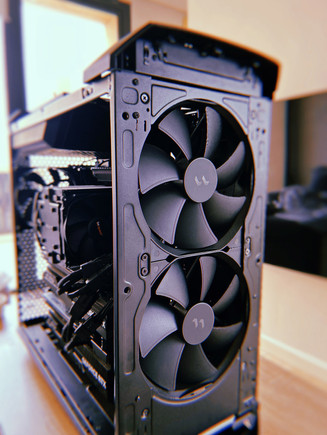CHOOSING THE RIGHT HARDWARE
- wiegerpoutsma

- Dec 15, 2024
- 4 min read
Updated: Dec 16, 2024
Around five years ago, I made the decision to switch from Apple MacPro to PC. As a lifelong Apple fan—ever since they released the first Macintosh—I loved the way Apple devices worked, especially with their seamless colorsync integration and how easy they were to use compared to the clunky PCs of that time. Back then, Apple had a significant advantage when it came to image, color profiles, and print workflows.

But PCs have come a long way since then. The clumsy, non-user-friendly machines of the past have transformed into sleek, powerful workstations. The fact that Apple closed up their hardware, making it nearly impossible to upgrade, made PC's modular design and customizability an appealing option. Price was another factor: compared to Apple, a fully custom-built PC offers much more bang for your buck. With most software written for PCs and GPU rendering becoming the norm, I felt it was time to make the switch.
The jump to PC and building my own custom system was a big leap for a Mac user, but once I dug into the process, I realized it wasn’t that complicated—and actually, it was a lot of fun. Understanding all the components, choosing the right brands and specs for my needs, was the biggest hurdle. But after some research, I came up with a setup that I could rely on for high-performance work.
My studio consists of three main computers: a powerful laptop for general tasks and communication, and two identical desktop PCs—one as my main workstation, and the other dedicated to background rendering. Both of my workstations feature a dual GFORCE 4090RTX GPU setup, which makes rendering a breeze. While the render station works on projects, my main workstation is free to tackle other tasks—or render two projects at once.
I chose air-cooled workstations instead of liquid cooling. This decision was driven by ease of use, low maintenance, and my collaboration with NVIDIA, who provided me with air-cooled GPUs. While living in the south of Spain, where summer temperatures reach over 40°C, I might consider liquid cooling in the future. But so far, everything runs smoothly, with the Fractal Design Torrent case and its large, quiet front fans providing excellent cooling. The Be Quiet! Dark Rock adds the finishing touch to my cooling setup.
Both workstations are built with the same specs:
Motherboard: ASUS ROG Zenith II Extreme Alpha
Processor: AMD Ryzen Threadripper 3970X 32-Core Processor (3.95GHz)
RAM: 256GB
GPU: Dual MSI Game Trio GeForce RTX 4090 (air-cooled)
Cooling: Be Quiet! Dark Rock Pro TR4
Case: Fractal Design Torrent
For screens, the choice was easy. For over 15 years, I’ve worked with Wacom, both as an ambassador and a tester. Since the release of the Wacom Cintiq Pro 27HD, I’ve been a fan of their pen displays. Currently, my main screen is the Wacom Cintiq Pro 27HDR, which is by far the best tool I’ve ever worked on. I use two Wacom Cintiq Pro 32s as side monitors. I can either switch both to extend the desktop of my main workstation or use one to extend the desktop of my laptop while using the other as a screen for my render station. The two Cintiq Pro 32s are mounted on Wacom Flex Arms, allowing for quick angle and position adjustments, while the Cintiq Pro 27HDR is mounted on a dedicated stand that provides the flexibility and sturdiness I need for drawing.
For input devices, I rely on the Logitech MX Keys, which allows me to switch between computers with a single button press, and two Logitech MX Master 3 mouses—one for the main workstation and one for the laptop. These sturdy, wireless devices help keep my desk tidy while offering a seamless work experience. I also use the 3DConnexion SpaceMouse Compact to make object manipulation in ZBrush and Maya easier, and an Elgato Stream Deck for quick access to apps and functions.
My workstation is backed up by a 30TB external system, which ensures I never run out of space for my projects. With this setup, I have all the flexibility I need for handling even the most demanding tasks.
When building my system, one of the biggest challenges was fitting the massive dual GPUs into the case. Cooling between the GPUs was a concern, but MSI had that covered with their well-designed cooling system, so temperature isn’t an issue. Power was another challenge, so I ended up using 1600W PSUs, which fit perfectly into the Fractal case.
As someone in the visual industry, functionality is key, but I also wanted a workstation that looked as good as it performed. The Fractal Design Torrent case has a sleek, minimalist look that doesn’t distract from my work, and the entire system is easy to upgrade and maintain.
This setup has provided the performance and flexibility I need, whether I’m working in Adobe, Maya, Blender, ZBrush, Painter, Octane Render, EmberGen, Gaea, or Unreal Engine. And when I need to unwind, Steam is there to give me access to any game I want to play.
Curious about how this setup helps bring your projects to life? Reach out, and let’s discuss how we can collaborate on your next creative venture.






















Comments